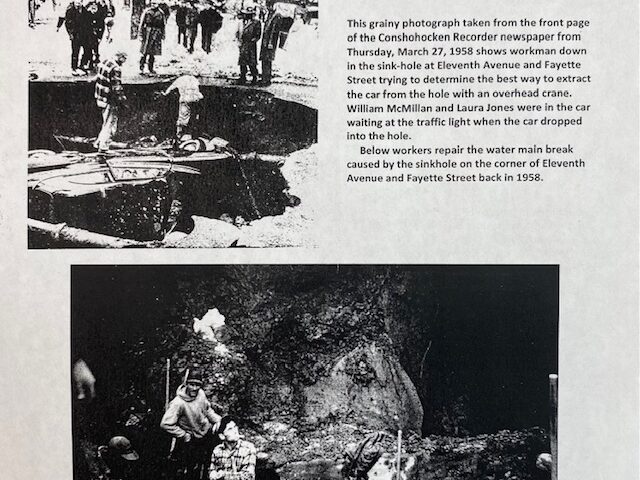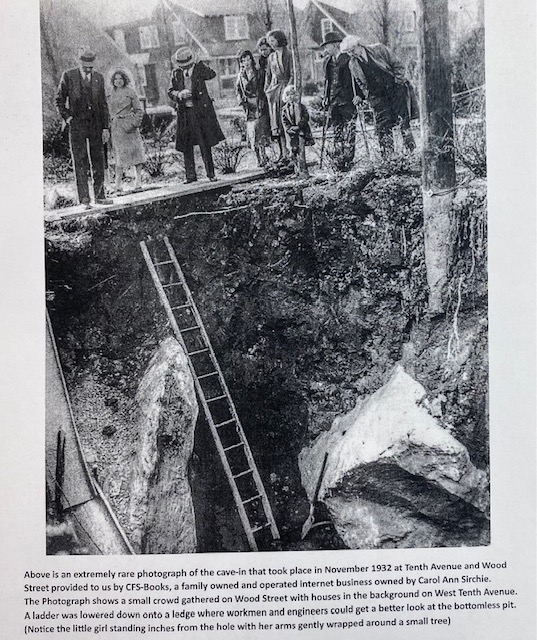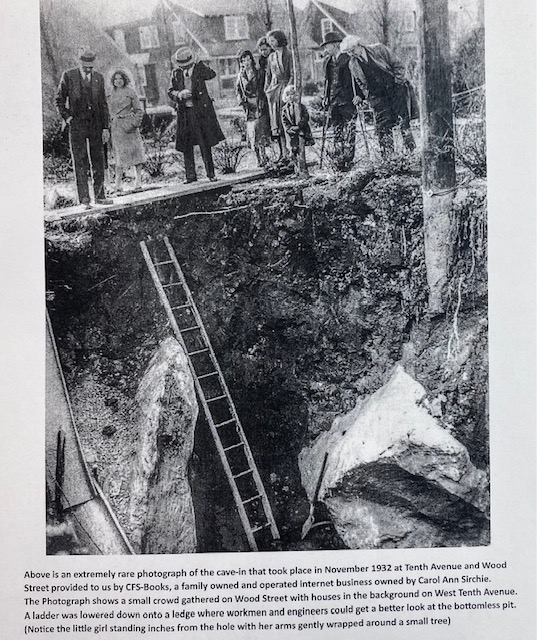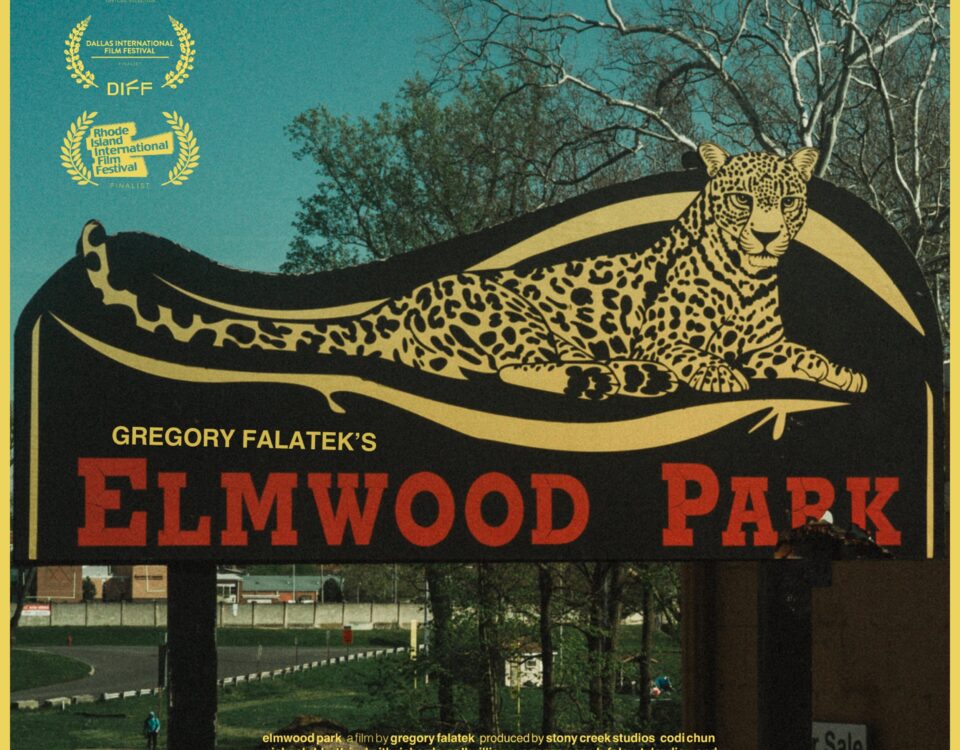
A Conshohocken Unsolved Murder Mystery
April 6, 2023Rants and Raves Conshystuff style
April 10, 2023Conshohocken’s Mysterious Cave-Ins – Do You Believe There’s a River Running Under Parts of Conshohocken?

Conshohocken’s Mysterious Cave-Ins
Do You Believe There’s A River Running Under
The West Side Of Conshohocken?
Read-On My Friends, Tell Me What You Think!
By Jack Coll
4-10-23
As most of our readers know Brian “Butch” Coll and myself have written a number of books over the years about Conshohocken and vicinity. Ironically, I was researching a subject that I had written about in the book “Conshohocken & West Conshohocken—People, Places and Stories.” While running through the book looking for information, I noticed the chapter “Murder, Mystery & Scandal” and thought it might be fun to reprint a portion of that chapter on “Conshystuff.”
I thought it might be interesting to reprint a small segment of the chapter titled “Mysterious Cave-Ins.” I remember researching this segment and thinking this seems unbelievable, but it was all true. Read-on and tell me what you think.
Taken from the book “Conshohocken & West Conshohocken—People, Places and Stories”

Mysterious Cave-Ins
It has been long rumored than an underground river flows through different parts of Conshohocken, and over the years mysterious cave-ins have given credence to those rumors. Cave-ins have been reported throughout the borough dating back to 1875.
In 1932, officials of the borough recalled that back in 1875 trouble caused by a cave-in of earth was experienced at the water basin, Twelfth Avenue and Fayette Street on a direct path east with the quarries and after quantities of material were poured in the break, the affected side of the basin was abandoned and the bottom rebuilt.
According to reports from 1932, James P. Shallow of 609 North 52nd Street, Philadelphia, a son of Bernard Shallow, who operated the O’Brien quarries in Conshohocken for many years, (The O’Brien quarries were located along Whiskey Lane, (Colwell Lane) from Second Avenue to Fifth Avenue from the 1860’s through the 1920’s. At that time Shallow stated that one day back in 1882 an unusually heavy blast dislodged stone below the spring water level, the depth of normal quarrying, workmen at the quarry were startled to find a swift flowing river, flowing east. A fifty-four-foot quarry rod, used to plumb its depths failed to touch the bottom. The hole was sealed up at the time and the river unmolested.
In the late fall of 1932 borough residents had enjoyed a Thanksgiving Day banquet with friends and family. Perhaps the topic of conversation was talk of eliminating the electric trolly cars that had rumbled up and down Fayette Street and Hector Street for nearly four decades. Residents had no sooner digested their holiday trimmings when word spread throughout the borough about a major cave-in, or sinkhole that occurred in the street at Tenth Avenue and Wood Street.
Local newspapers described the cave-in as a “Mystery-hole” and “Bottomless pit.” The mystery hole was first noticed by residents who lived in the area of the intersection as a small crack in the road on Wood Street. The road-crack was noticed by residents in the fall of 1931, thinking it was nothing more than a storm washout, something that was quite common back then. Gradually, over time the crack widened and deepened, and it became more alarming that pedestrians and traffic might be endangered. Borough leaders and engineers believed that the crack in the road would be nothing more than the standard fix which in all fairness was something they had dealt with several times a year, fixing what was then the back roads of the borough.
Finally in November 1932 the hole opened up and became a bottomless pit, no light dropped down in the hole could shine light on the bottom of the pit. Objects dropped in the hole with inspectors waiting to hear a sound, like the object hitting the bottom was never heard. The borough started to bring in truck-loads of hardened concrete, taken from the old Aronomink Bridge, demolished for replacement by a new bridge. Truck load after truck load, ton after ton, and before long more than 100 tons of stone and concrete were poured into the hole and the results were the same as when they started. The concrete was all swallowed up completely by an unseen abyss, there was still no bottom in sight, or sound.
The following week the “bottomless pit” attracted thousands of visitors and onlookers on a Saturday and Sunday from nearby counties and states. Traffic was stopped on Fayette Street throughout the day on Sunday with motorist asking anyone and everyone for directions to the “mystery hole,” causing somewhat of a traffic jam. The crowds became so extensive throughout the day that police from Conshohocken and other nearby communities were called to the scene to direct traffic and prevent the visitors from getting too close to the mysterious cavern and falling in.
After gathering information about past borough cave-ins, William Muldrew, borough engineer, learned that perhaps an underground waterway really did exist in the borough. It was feared that this was no ordinary sinkhole by perhaps they were dealing with an underground cavern of alarming proportions. As Muldrew continued in inspect the hole he was lowered about fifteen feet into the hole dropping objects that were never heard hitting the bottom and determined that perhaps the hole was hundreds if not thousands of feet deep into the earth’s interior.
Within a week of the holes appearance two smaller holes appeared alarming the community even more. One of the holes appeared 125 feet from the original hole, the other a short distance away. Both holes were located on a vacant lot at the southeast corner of Tenth Avenue and Wood Street. The one hole sank to a depth of about ten feet and the other hole was very shallow. The Conshohocken Recorder newspaper described the two holes as though, “sucked in by some giant subterranean breath,” and it was further noted that both holes were in a direct easterly line with the first cave-in.
The initial conclusion by the borough’s engineer and other outside sources working on the problem was that it appeared that the mystery-hole was caused by subterranean stream that is drawing in the earth from this section of town. (Well, that must have been a relief to the residents whose houses were within twenty feet of the hole). The engineers went on to report at the time that it appeared that the earth had been gradually washing away before collapsing the earth above the stream or river underneath the surface. Adding to the problem was the fact that a six-inch water main had burst near the cave-in due to the ground collapsing.
The collapse revealed huge slabs of stone that are part of the great limestone vein that runs through that part of Conshohocken above and below the surface that also puts the lower section of Conshohocken on the west side on line with an earthquake fault. (That would be another chapter for another time).
Geologist brought on sight at the time determined that the estimated depth of this lime strata as more than thirty-five thousand feet. If the hole had been caused by a splitting in this strata, (meaning a splitting in these large layers of rock or lime stones) the gap may run as deep into the earth’s bowels as the six mile depth of the strata.
After countless tons and truckloads of cement and debris had been poured into the bottomless pit, a floor or bridge was created some twenty five feet below the surface of the pit and appeared to do the job. In the months following the street was returned to a normal operating condition, the crowds of onlookers had disappeared. In the following months, maybe years of residents speculating about the next great bottomless pit, the mystery cave-in became just another tale that grandparents would tell their grandchildren while sitting around the Thanksgiving Day table.
I’m sure the grandchildren, and perhaps their parents, rolled their eyes more than once upon hearing about the great bottomless pit over the years. You could throw a rock into the hole, and it would never hit the bottom, because it was, a bottomless pit.
With the great cave-in of 1932 still fresh on the minds of local residents, word of a cave-in arrived in 1938 that happened on West Elm Street in Connaughtown just outside the steel plant. A large section of West Elm Street had collapsed endangering traffic and pedestrians. Within a short period of time also in 1938 several minor cave-ins appeared at Twelfth Avenue and Fayette Street.
Also, in 1938 it was reported that Mrs. Clarence Knode who lived at Ridge Pike and Spring Mill Road in Harmonville, had looked out her window where a fifteen foot tree had been located for several years. When she looked out the window minutes later the tree was gone, it was swallowed whole disappearing into the bowels of the earth as a major hole opened up in her yard. Although it happened in Harmonville, residents in Conshohocken were very concerned.
Two years later in 1940, again at Twelfth Avenue and Fayette Street, this time at a different location just outside Tinney Ford Motor Company, the earth cracked wide open and a large cave-in had appeared, no cars were lost in the sink-hole.
The Norristown Times Herald newspaper had reported in 1945 that such troubles with sinkholes were a frequent occurrence in the 1930’s and early 1940’s in the northern part of the borough on the approaches to the limestone lands. In 1945 a sinkhole occurred as far south as West Seventh Avenue, when more than 22 truckloads of stone and cinder were required to fill the hole.
Paul Lacey of Collegeville was a truck driver who delivered home heating oil for Tydol Oil Company based in Collegeville. On January 1, 1946 Paul drove his four ton oil truck loaded with fuel up to the home of Walter Winterbottom at 443 West Tenth Avenue to make a delivery. According to Paul at the time he pulled up in front of Winterbottom’s house and felt the truck start to sink on the right side. Paul was a little mystified and jumped out of the truck to see the entire right side of the truck slowly sinking into the street, and only stopped sinking after the two right wheels were off the ground. Paul delivered 150 gallons of fuel oil to Witterbottom’s house while waiting to a Tydol repair truck to arrive on the scene. With a little help from a tow truck the oil truck was slowly righted and Paul was on his way.
The West Tenth Avenue sink-hole at the time was never officially termed a “Cave-in,” it was pointed out at the time that the break in the road was less than two blocks west of the borough’s worst cave-in experienced at Tenth Avenue and Wood Street 14 years earlier back in 1932.
It had been reported repeatedly over the centuries that ever-since quarries had been operating in Conshohocken, Plymouth and Whitemarsh evidence came to light from time to time of the existence of abounding underground streams and rivers of water in the region.
The first attempt to study this condition seems to have been made by the Cabinet of Natural Sciences of Montgomery County, composed of young men holding periodical meetings in Norristown. In 1834 a paper was read at one of these meetings on “The Caverns of Plymouth and Whitemarsh.” It was considered important enough to bring about its publication in a newspaper, though the name of the writer did not appear.
Dr. Hiram Corson of Plymouth Meeting, then a young man and later a physician of distinguished attainments, was a member of the Cabinet and the careful preparation of the paper on the Caverns suggest he wrote it. Mention was made of various “sinking’s” in proximity to quarries. Ten years earlier, it was told the surface of the ground to the extent of an acre sank near Pete Dager’s marble quarry, bordering Ridge Pike near Butler Pike.
About that time with all the talk of the underground water channels it seemed to interest Charles Heber Clark, author of a series of popular funny stories sold nation-wide who went under the pen name of Max Adeler. Clark resided for many years on East Fifth Avenue in Conshohocken. In his book “Elbow Room,” he told the grotesque story of the man who died and was buried in a new cemetery and a few days later his coffin was found floating out into river, suggesting that once under the earth, the coffin was swept up in the underground river and surfaced floating in the Schuylkill River.
(Much of the above information was taken from the Norristown Times Herald newspaper)

Another in the long list of Conshohocken mysterious cave-ins happened in March of 1958 when a car sitting at the intersection of Eleventh Avenue and Fayette Street waiting to make a right-hand turn onto West Eleventh Avenue just starting sinking into the roadway.
William A. Millan, a 20 year old Princeton University sophomore of Wynnewood was out on a date with 20-year old Loura Jones of 138 West Eleventh Avenue. The young couple had just finished a night on the town and McMillan was sitting at the light waiting to take Laura home when suddenly the earth opened up under the car and according to the Conshohocken Recorder newspaper “Hurled the car into a watery abyss.”
The car dropped hard below the roadway into a pond of water, Laura was knocked out when her head hit the windshield. McMillan worked hard and quick to save Laura and get her safely out of the car and back on solid ground from the 30 foot wide, nearly 20 feet deep hole quickly filling with water.
McMillan remembered pulling up to the light into a big puddle of water, (A puddle remains today every time after a hard rain) Adding to the problem and confusion it was a dark moonless night, while waiting at the light suddenly the two right wheels of the car sank deep into the roadway, tilting the car almost sideways, before the confusion could sink-in as to what was happening within seconds of the car tilting on its side the car just dropped into the huge water filled hole.
Among the confusion although badly bruised even through Laura was knocked silly the two managed to escape the trapped car as the muddy waters kept rising around them.
Conshohocken firefighter Carl Schultz happened to be returning from a fire location on that night at Twelfth Avenue and Wood Streets and returning from the fire scene arrived at the intersection in time to see the two shadowy figures apparently rising out of the hole in the unlighted street. The two kids were soaking wet with the muddied waters and Schultz transported them to the firehouse where they changed into overalls.
It was determined that a water line had fractured under the street surface, five hours earlier and homes in the area were without water or had very low water pressure. When officials returned to the Fayette Street pond, they summoned officials from the Philadelphia Suburban Water Company. A crew arrived on the scene and as soon as they shut off the water valve in the area the water in the hole disappeared within minutes into the earth.
We wonder today how the young couple made out. We wonder if William McMillian ever returned to Conshohocken. And we wonder if anyone in later years would even believe their story of a date night gone wrong? Everyone at some point in their life had a lousy date, the food wasn’t that good, flat tire, perhaps a lousy movie, and of course ran out of gas, but not many couples in the world get to tell this story.

Even as late as the 1990’s and 2000’s Fayette Street at the Eleventh Avenue traffic light housed large puddles following rainfalls. The street at that intersection has been repaired more times than we care to count due to the surface dipping into the earth., is it caused by a water main? Or could it be that Conshohocken really does have an underground river flowing under us?
So that’s just one of the many segments that make up the chapter “Murder, Mystery & Scandal” taken from the book “Conshohocken & West Conshohocken People, Places and Stories” written by Jack and Brian Coll.
So what do you think, is it possible that a river ran under Conshohocken all those years ago, is it possible that a river still runs under the borough even today? Perhaps a little something to think about the next time a small sinkhole shows up in your backyard, and remember, it was just a few years ago that a major sinkhole opened up on West Sixth Avenue.
Conshystuff continues to enjoy bringing you Conshohocken’s and West Conshohocken’s most prominent residents both past and present, we also enjoy shinning a small light on our history no matter how small, no matter how long ago. After reading a piece about our history it’s nice to sit back in your seat and think, “How cool is that.”
Conshystuff also enjoys promoting our local businesses like our advertisers, we have personally used many of our advertisers and highly recommend using their services.

